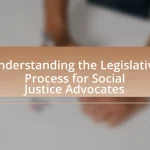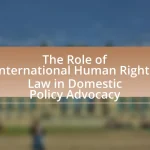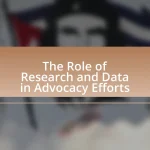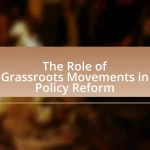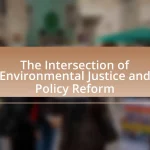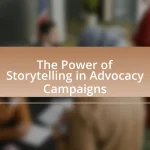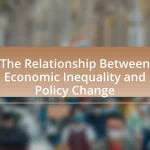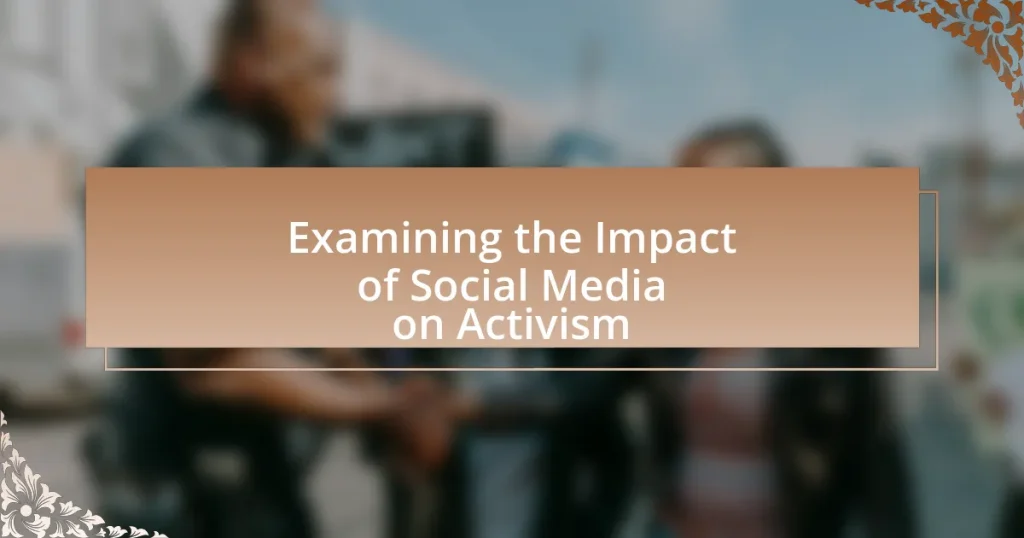The article examines the impact of social media on activism, highlighting its role in enhancing communication, mobilization, and community engagement. It discusses how platforms like Twitter and Facebook have transformed traditional activism by enabling rapid information dissemination and grassroots organization, as evidenced by movements such as the Arab Spring and Black Lives Matter. Key features of social media, including rapid outreach and community building, are analyzed, along with the challenges activists face, such as misinformation and censorship. The article also explores the influence of social media on public perception, policy change, and the future trends in digital activism, emphasizing the importance of strategic engagement and authenticity in online campaigns.
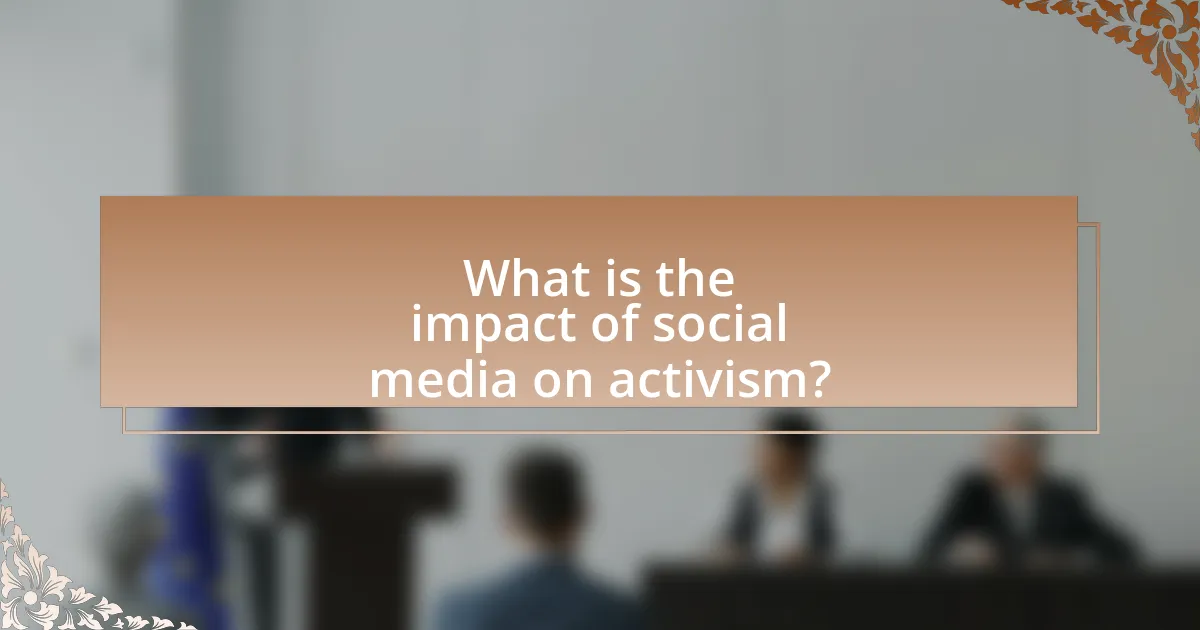
What is the impact of social media on activism?
Social media significantly enhances activism by providing a platform for rapid information dissemination and mobilization. It allows activists to reach a global audience instantly, facilitating the organization of protests and campaigns. For instance, the Arab Spring in 2011 demonstrated how platforms like Twitter and Facebook enabled activists to coordinate efforts and share real-time updates, leading to widespread political change in several countries. Additionally, studies show that social media can increase engagement and participation in social movements; a 2018 Pew Research Center report indicated that 69% of adults in the U.S. believe social media is an effective tool for raising awareness about social issues. Thus, social media plays a crucial role in amplifying activist voices and fostering community engagement.
How has social media transformed traditional activism?
Social media has transformed traditional activism by enabling rapid communication, broadening outreach, and facilitating grassroots organization. Platforms like Twitter and Facebook allow activists to disseminate information instantly, mobilizing supporters across vast geographical areas. For instance, the Arab Spring in 2010-2011 showcased how social media could coordinate protests and share real-time updates, leading to significant political changes in multiple countries. Additionally, studies indicate that social media campaigns can engage younger demographics more effectively than traditional methods, as seen in movements like Black Lives Matter, which gained momentum through viral hashtags and online engagement. This shift illustrates that social media not only enhances visibility but also empowers individuals to participate in activism from anywhere, fundamentally altering the landscape of social movements.
What are the key features of social media that facilitate activism?
The key features of social media that facilitate activism include rapid information dissemination, community building, and mobilization capabilities. Rapid information dissemination allows activists to share news and updates instantly, reaching a global audience; for example, during the Arab Spring, social media platforms like Twitter and Facebook played crucial roles in spreading information about protests. Community building enables like-minded individuals to connect, share resources, and support each other, as seen in movements like Black Lives Matter, which utilized social media to create a strong network of advocates. Mobilization capabilities allow for organizing events and campaigns efficiently, exemplified by the Ice Bucket Challenge, which raised awareness and funds for ALS through viral participation. These features collectively enhance the effectiveness of activism in the digital age.
How do social media platforms differ in their impact on activism?
Social media platforms differ in their impact on activism primarily through their audience reach, engagement mechanisms, and content formats. For instance, platforms like Twitter facilitate rapid dissemination of information and real-time engagement, which can mobilize support quickly during crises, as seen in movements like #BlackLivesMatter. In contrast, Instagram’s visual-centric approach allows for storytelling through images and videos, fostering emotional connections and raising awareness about social issues, exemplified by campaigns like #MeToo. Additionally, Facebook’s community-building features enable the formation of groups that can sustain long-term activism efforts, as demonstrated by various environmental movements. Each platform’s unique characteristics shape how activists communicate, organize, and engage with their audiences, ultimately influencing the effectiveness of their campaigns.
Why is social media a crucial tool for modern activists?
Social media is a crucial tool for modern activists because it enables rapid communication and mobilization of support for social causes. Activists can reach a global audience instantly, facilitating the spread of information and awareness about issues such as climate change, racial justice, and human rights. For instance, the Black Lives Matter movement gained significant traction through platforms like Twitter and Instagram, where hashtags and viral posts galvanized millions to participate in protests and discussions. Additionally, studies show that social media campaigns can increase engagement and donations, with a report from the Pew Research Center indicating that 69% of adults in the U.S. use social media, making it an effective channel for outreach and fundraising.
What advantages does social media provide for grassroots movements?
Social media provides grassroots movements with enhanced visibility and the ability to mobilize supporters quickly. This platform allows activists to share their messages widely, reaching diverse audiences beyond traditional media limitations. For instance, the #BlackLivesMatter movement gained significant traction through social media, facilitating global awareness and participation in protests. Additionally, social media enables real-time communication and coordination among supporters, which is crucial for organizing events and campaigns effectively. Research indicates that social media can increase engagement and participation rates, as seen in various movements that have successfully utilized these platforms to rally support and drive change.
How does social media enhance visibility for social causes?
Social media enhances visibility for social causes by providing a platform for widespread dissemination of information and engagement. It allows organizations and individuals to share messages, mobilize supporters, and create viral campaigns that reach a global audience. For instance, the Ice Bucket Challenge in 2014 raised over $115 million for ALS research through social media participation, demonstrating how online platforms can amplify awareness and drive fundraising efforts. Additionally, social media facilitates real-time communication and community building, enabling users to connect with like-minded individuals and organizations, further increasing the reach and impact of social causes.
What challenges do activists face when using social media?
Activists face several challenges when using social media, including censorship, misinformation, and digital surveillance. Censorship occurs when platforms restrict or remove content that is deemed controversial or politically sensitive, limiting activists’ ability to communicate their messages effectively. Misinformation can spread rapidly on social media, undermining the credibility of activist campaigns and creating confusion among the public. Digital surveillance poses a significant risk, as activists may be monitored by governments or hostile entities, leading to potential harassment or legal repercussions. According to a report by Freedom House, 2021, 73% of countries experienced a decline in internet freedom, highlighting the increasing challenges activists face in the digital landscape.
How can misinformation affect activist movements on social media?
Misinformation can significantly undermine activist movements on social media by spreading false narratives that distort public perception and erode trust. For instance, during the Black Lives Matter protests in 2020, misinformation regarding protest activities led to confusion and division among supporters, ultimately hindering collective action. Studies have shown that misinformation can decrease engagement and participation in movements, as individuals may become skeptical of the information shared within their networks. This skepticism can lead to fragmentation of the movement, as activists may struggle to unify under a common cause when faced with conflicting information.
What are the risks of surveillance and censorship for activists online?
Surveillance and censorship pose significant risks for activists online, primarily by compromising their safety and limiting their ability to organize and communicate. Surveillance can lead to the identification of activists, making them vulnerable to harassment, arrest, or violence from authorities or opposing groups. For instance, the 2011 Arab Spring highlighted how governments monitored social media to track and detain protesters. Censorship restricts access to information and stifles free expression, hindering the dissemination of critical messages and mobilization efforts. According to a report by Freedom House, 2021 saw a rise in internet censorship in 45 countries, impacting activists’ ability to operate effectively. These risks create an environment of fear and repression, ultimately undermining the goals of social movements.
How do social media campaigns mobilize support for activism?
Social media campaigns mobilize support for activism by leveraging platforms to disseminate information rapidly and engage users in meaningful dialogue. These campaigns utilize targeted messaging, hashtags, and visual content to raise awareness about specific issues, encouraging users to share and participate. For instance, the #BlackLivesMatter movement gained significant traction through social media, leading to widespread protests and policy discussions, demonstrating the effectiveness of online mobilization in driving real-world action.
What role do influencers play in social media activism?
Influencers play a crucial role in social media activism by amplifying social causes and mobilizing their followers for action. They leverage their large audiences to raise awareness about issues such as climate change, racial equality, and mental health, often leading to increased engagement and support for these causes. For instance, a study by the Pew Research Center found that 70% of young adults are more likely to support a cause when they see it promoted by influencers they follow. This demonstrates that influencers can significantly impact public opinion and drive social change through their platforms.
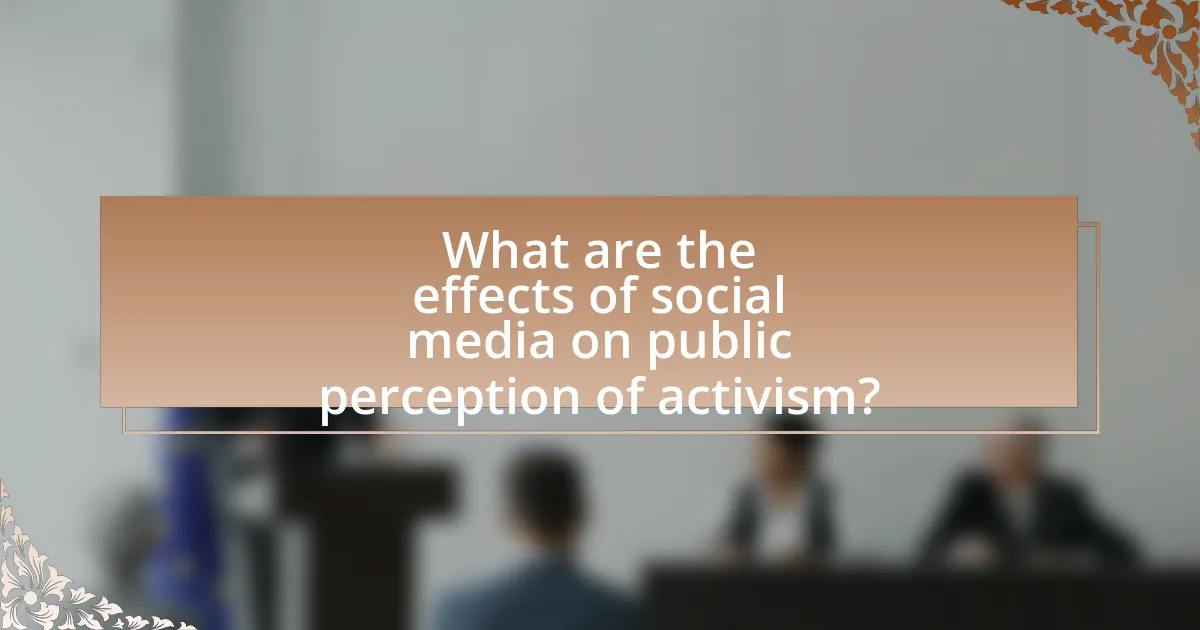
What are the effects of social media on public perception of activism?
Social media significantly shapes public perception of activism by amplifying voices and increasing visibility for various causes. Platforms like Twitter and Instagram allow activists to reach broader audiences quickly, fostering community engagement and mobilization. For instance, the Black Lives Matter movement gained global attention through social media campaigns, leading to increased awareness and support for racial justice issues. Research indicates that social media can enhance the perceived legitimacy of movements, as seen in studies showing that online engagement correlates with higher public support for activism (e.g., “The Role of Social Media in Activism” by Smith et al., 2020). Thus, social media serves as a powerful tool in influencing how activism is perceived by the public.
How does social media shape narratives around social movements?
Social media shapes narratives around social movements by providing a platform for rapid information dissemination and community engagement. This immediacy allows activists to share their messages widely, mobilize supporters, and frame issues in ways that resonate with diverse audiences. For instance, during the Black Lives Matter movement, hashtags like #BlackLivesMatter enabled users to share personal experiences and organize protests, significantly influencing public discourse and media coverage. Research indicates that social media can amplify marginalized voices, as seen in studies showing increased visibility for social justice issues through platforms like Twitter and Instagram.
What impact does user-generated content have on public opinion?
User-generated content significantly shapes public opinion by providing diverse perspectives and fostering community engagement. This content, often shared on social media platforms, allows individuals to express their views, experiences, and emotions, which can influence the perceptions and beliefs of others. For instance, a study by the Pew Research Center found that 64% of Americans believe social media has a mostly positive effect on the way things are going in the country, highlighting its role in shaping collective attitudes. Furthermore, user-generated content can amplify marginalized voices, leading to increased awareness and support for social issues, as seen in movements like Black Lives Matter, where personal stories and videos have mobilized public sentiment and action.
How do hashtags influence the visibility of social issues?
Hashtags significantly enhance the visibility of social issues by categorizing content and facilitating its discovery across social media platforms. When users employ specific hashtags, they create a searchable link that aggregates related posts, making it easier for individuals to find and engage with discussions surrounding particular social issues. For instance, the hashtag #BlackLivesMatter has been instrumental in raising awareness about racial injustice, leading to widespread media coverage and public discourse. Research indicates that posts with relevant hashtags receive 12.6% more engagement than those without, demonstrating their effectiveness in amplifying messages and mobilizing support for social causes.
What are the implications of social media activism for policy change?
Social media activism significantly influences policy change by amplifying marginalized voices and mobilizing public support. This digital platform enables rapid dissemination of information, allowing activists to organize campaigns that can reach a global audience. For instance, the #BlackLivesMatter movement utilized social media to raise awareness about systemic racism, leading to policy discussions and reforms in law enforcement practices across various cities in the United States. Research indicates that social media can increase civic engagement, with a study by the Pew Research Center showing that 69% of adults in the U.S. believe social media is an effective tool for promoting social change. Thus, social media activism not only raises awareness but also pressures policymakers to respond to public demands, demonstrating its critical role in shaping policy outcomes.
How can social media campaigns lead to legislative action?
Social media campaigns can lead to legislative action by mobilizing public support and raising awareness about specific issues. These campaigns often utilize hashtags, viral content, and targeted messaging to engage a wide audience, which can pressure lawmakers to respond to constituents’ demands. For instance, the #MeToo movement significantly influenced legislative changes regarding sexual harassment laws in various states, demonstrating how social media can effectively translate public sentiment into political action. Additionally, studies show that social media platforms can amplify grassroots movements, making it easier for activists to organize, share information, and advocate for policy changes, ultimately leading to legislative outcomes.
What examples exist of successful policy changes driven by social media activism?
Successful policy changes driven by social media activism include the legalization of same-sex marriage in the United States and the global response to climate change through movements like Fridays for Future. The legalization of same-sex marriage was significantly influenced by campaigns on platforms like Facebook and Twitter, where activists mobilized public support and shared personal stories, culminating in the Supreme Court’s decision in 2015. Similarly, the Fridays for Future movement, initiated by Greta Thunberg, utilized social media to raise awareness and pressure governments worldwide to adopt more aggressive climate policies, leading to commitments from various nations to reduce carbon emissions. These examples illustrate how social media can effectively amplify voices and drive legislative change.
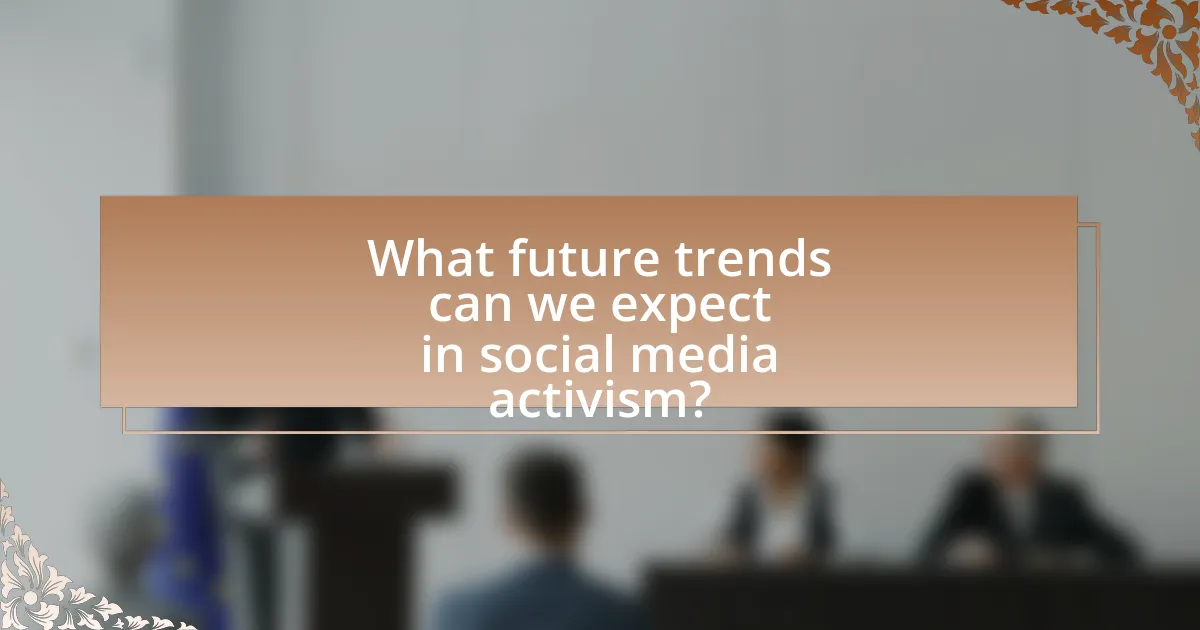
What future trends can we expect in social media activism?
Future trends in social media activism will likely include increased use of artificial intelligence for targeted messaging and mobilization. As platforms evolve, algorithms will enhance the ability to identify and engage specific audiences, making campaigns more effective. Additionally, the rise of decentralized social media platforms may empower activists by reducing censorship and increasing privacy. A report by the Pew Research Center indicates that 69% of Americans believe social media is an effective tool for activism, highlighting its growing importance. Furthermore, the integration of augmented reality and immersive experiences in campaigns can create more engaging narratives, driving higher participation rates.
How might emerging technologies influence activism on social media?
Emerging technologies significantly influence activism on social media by enhancing communication, mobilization, and engagement strategies. For instance, the rise of artificial intelligence and machine learning allows activists to analyze large datasets, identify trends, and target specific audiences more effectively. Additionally, blockchain technology can ensure transparency and security in fundraising efforts, fostering trust among supporters. A study by the Pew Research Center in 2021 found that 69% of Americans believe social media is an effective tool for activism, highlighting its growing importance in contemporary movements. These technologies not only streamline the organization of protests and campaigns but also amplify voices that may otherwise be marginalized, thereby reshaping the landscape of social activism.
What role will artificial intelligence play in shaping activist strategies?
Artificial intelligence will significantly enhance activist strategies by enabling data analysis, targeted messaging, and real-time engagement. AI tools can analyze vast amounts of social media data to identify trends, sentiments, and key influencers, allowing activists to tailor their campaigns effectively. For instance, AI algorithms can process millions of tweets or posts to gauge public opinion on specific issues, helping activists to refine their messaging and outreach efforts. Additionally, AI-driven chatbots can facilitate real-time communication with supporters, increasing engagement and mobilization during campaigns. This strategic use of AI has been evidenced in movements like Black Lives Matter, where data analytics played a crucial role in organizing protests and spreading awareness.
How could virtual reality enhance the experience of social movements?
Virtual reality could enhance the experience of social movements by providing immersive environments that foster empathy and understanding among participants. This technology allows individuals to experience the challenges faced by marginalized groups firsthand, which can lead to increased awareness and support for social causes. For instance, studies have shown that virtual reality experiences, such as those simulating the experiences of refugees or victims of discrimination, can significantly increase empathy levels in users, as evidenced by research conducted by the University of Southern California, which found that participants who engaged in VR simulations reported a greater emotional connection to the issues presented. By creating a visceral connection to social issues, virtual reality can mobilize individuals and encourage collective action, ultimately strengthening social movements.
What best practices should activists follow when using social media?
Activists should prioritize authenticity, engagement, and strategic messaging when using social media. Authenticity builds trust with followers, as seen in campaigns like #BlackLivesMatter, where personal stories resonated deeply with audiences. Engagement is crucial; responding to comments and participating in discussions fosters community and encourages broader participation. Strategic messaging involves clear, concise communication of goals and calls to action, which has proven effective in mobilizing support for various movements. For instance, the Ice Bucket Challenge effectively raised awareness and funds for ALS through a well-crafted social media strategy.
How can activists effectively engage their audience online?
Activists can effectively engage their audience online by utilizing targeted social media strategies that foster interaction and community building. By creating compelling content that resonates with their audience’s values and interests, activists can encourage sharing and discussion. For instance, studies show that posts with visuals receive 94% more engagement than text-only posts, highlighting the importance of multimedia in capturing attention. Additionally, leveraging hashtags can increase visibility and connect activists with broader conversations, as evidenced by the #BlackLivesMatter movement, which gained global traction through strategic online engagement.
What strategies can be employed to combat misinformation in activism?
To combat misinformation in activism, organizations can employ fact-checking, media literacy education, and transparent communication strategies. Fact-checking involves verifying claims before sharing them, which can reduce the spread of false information; for instance, platforms like Snopes and FactCheck.org provide reliable resources for activists. Media literacy education equips individuals with skills to critically evaluate information sources, fostering a more informed activist community. Transparent communication, where organizations openly share their sources and methodologies, builds trust and encourages accountability, as seen in successful campaigns by groups like the American Civil Liberties Union (ACLU). These strategies collectively enhance the integrity of information disseminated within activist movements.
